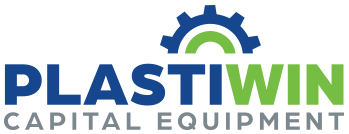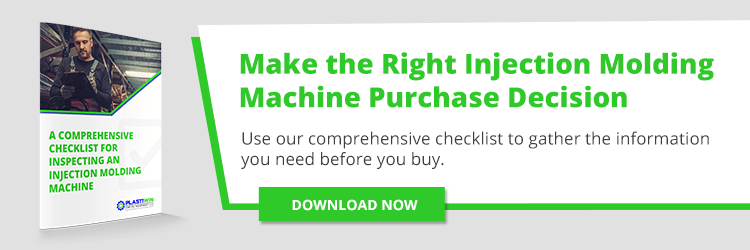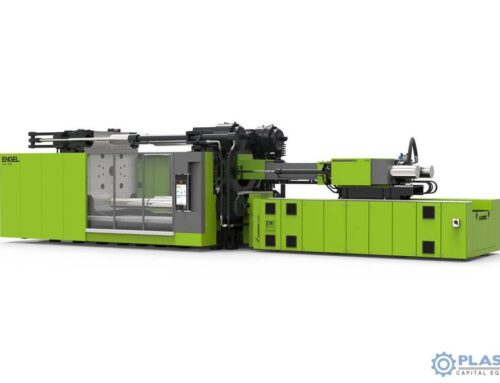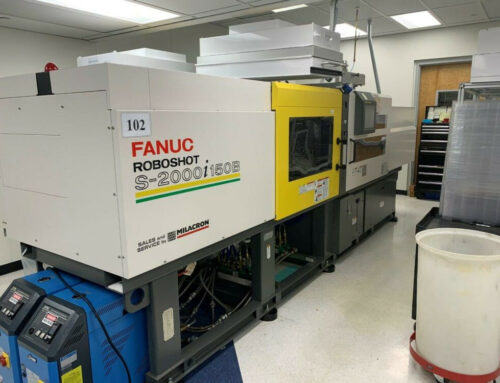You’ve decided to purchase a piece of used plastics machinery for your business and found a listing you’re interested in. All you need to do now is go out and buy it, right? STOP! There’s one very important thing you need to do first:
Conduct a Thorough Machinery Inspection with Our Used Plastic Process Machinery Checklist
Conducting a proper inspection now can have a laundry list of benefits for your business later—such as lowering the risk of workplace injuries (meaning a safer environment for your employees and decreased workers’ compensation premiums for you), reducing long-term maintenance and repair costs, and increasing productivity and efficiency.
So, what should your inspection cover? Here’s an easy-to-follow machinery inspection checklist outlining 14 major things you need to look for before making a purchase.
- Overall Appearance
A machinery inspection checklist should always include a visual inspection. By simply looking at a piece of machinery, you can easily tell if there are cracks, rust, dents, scratches, or fluid leaks from substances such as water or hydraulic oil. You should also check the condition of important parts, such as hoses, wires, and cables, and be sure the machine has not been disconnected or broken down to parts.
- Condition of Environment
The next thing your equipment inspection checklist should look into is the environment and conditions in which the machine is being used. Is the area climate controlled? If not, is the warehouse or factory it is being used in extremely hot, humid, or cold? If machinery is exposed to extreme conditions or water or used in dirty, unsafe conditions with parts and tools laying everywhere, it could result in maintenance issues over time.
For example, machinery that has been running in an OSHA and FDA regulated medical cleanroom is probably in pretty great condition. On the other hand, if a piece of machinery is located in a facility that ignores routine maintenance and isn’t up to safety standards, it could be a red flag that you’ll run into issues in the future.
- Under Power
As part of your equipment inspection checklist, it is important to physically see the machine running and producing parts. Make sure it is not making any funny noises while running. If you’re an experienced operator or have been in a business that relies on machinery for a while, you likely know how a machine normally sounds. Be sure to listen closely for any unusual sounds that may indicate a repair is needed.
- Electrical
Your machinery inspection checklist should always cover the electrical aspects of a machine. After all, the machine may look just fine, but if there are electrical problems, it won’t be able to run smoothly once you get it.
- Check if there are missing cards, disconnected or terminated wires, or missing circuit boards.
- Check the voltage to make sure it will run properly in your current facility.
- Power consumption is important environmentally and in many communities.
- Check the amperage draw of the machinery you are buying.
- The less power used, the lower your electricity bill will be.
- Preventative Maintenance Schedule
Review the machinery’s maintenance records, if they are available, to see if the previous owners had a preventative maintenance schedule in place. If so, how often did these safety and maintenance checks occur—daily, weekly, monthly, or annually? Be sure your machinery inspection checklist includes finding out when the last time preventative maintenance was done to avoid the need for any costly surprise repairs later.
- Updates
As part of your equipment inspection checklist, inquire if any upgrades have been made to the machinery.
- Have there been electronic updates?
- Has a new controller, motor, or gearbox been installed?
- If so, when, and for what reasons?
- Were there chronic issues with a particular part of the machine, or was the update necessary after normal wear and tear?
- Availability of Spare Parts
Your machinery inspection checklist should also include some of your own research to see if replacement and spare parts for the particular piece of machinery will be easy to obtain. This avoids surprises later on if something breaks and you weren’t aware it would take so much time to locate the parts and wait for them to be delivered. This could cost you in machinery downtime.
- Rigging and Shipping
Consider where the machine is currently located, and how easily it will be to remove it and bring it into your plant or warehouse.
- Was the machine so big it had to be assembled on-site to fit through the door?
- If so, can it be disassembled without damage?
- If the machine can be moved, will it fit through your existing dock doors once it arrives?
- Be sure to also consider what it would cost to dismantle and reassemble the machine.
It’s also important to take into account the location of the machine in relation to your plant, and the cost of moving the equipment to your facility. For example, if you have a project that requires the machinery in two weeks and it will take over a month to ship, that could cause a big issue.
- Any Recurring Issues
Be sure to ask whoever you are speaking with (whether that is an engineer, maintenance manager, plant manager, or production manager) why the machine was taken out of service in the first place. Be sure to ask if there were any specific issues that led them to sell it, or if they were simply ready for an upgrade or needed a different type of machinery. Also ask the question: “If you were to put this on another one year run, what would you do to the machine?”
- Mechanical
As part of your machinery inspection checklist, take an oil sample and check all filters, manifolds, and valves. Inquire about the age of the oil and all motors, plus how many hours of runtime and number of cycles the machine has endured. Additionally, check the condition of heater bands and all heating elements.
- Plastic Type and Products Produced
Overall, it is important for a buyer to know what type of plastic material is run on any machine. It is also important for a buyer to examine the parts produced by the machine to make sure there are no faults with the final product.
- Safety Features
Your equipment inspection checklist should always cover what safety features the machinery is equipped with. After all, one of the main reasons to conduct a thorough inspection is to ensure the safety of your employees. Therefore, if safety features are lacking, this is not something you should compromise on. Not only will it put your staff at risk — it could result in hefty fines and higher worker’s compensation premiums if you’re not meeting OSHA guidelines.
- Here is an in-depth machinery inspection checklist template provided by OSHA that you may want to print out and take with you during your inspection!
Buying used machinery is a great way to get the best return on your investment—but not if you were unaware of problems or maintenance issues that require you to pay costly repairs later. Now that you know what to look for when inspecting used machinery, you’re ready to find the right piece to add to your fleet.
This sample safety inspection checklist gives you a great place to start with big-picture considerations you should make before a used machinery purchase. Remember to always document everything so you can refer to it later and have proof of the machinery’s condition when you purchased it.
At PlastiWin, we are more than a plastics processing machinery supplier; we also offer a variety of specialized services such as the liquidation of used plastics processing equipment lines, the purchasing of plastic process manufacturing facilities, and appraisals for all types of plastic, chemical, and rubber processing equipment.
For more information about purchasing used machinery, reach out to one of our experts today!





